The African violet flowers almost all year round - a small plant with a great effect. However, it has nothing to do with real violets.
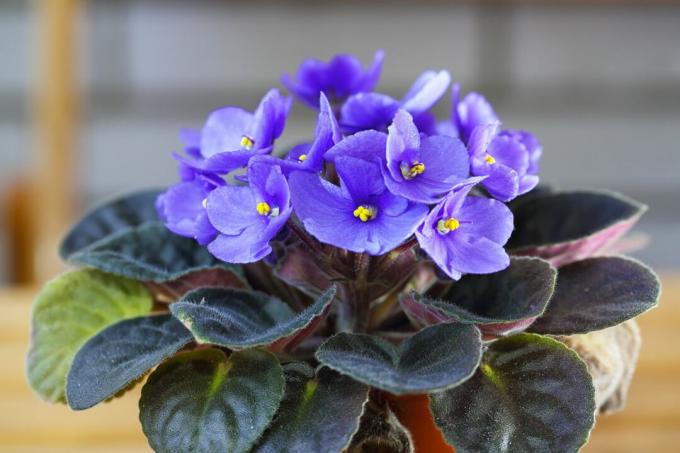
With its brightly colored flowers in a wide variety of color combinations, the African violet (Saintpaulia ionantha) a real eye-catcher. No wonder some people have developed a passion for collecting. Here you can find out how to care for the special plant in your own four walls.
contents
- African violets: origin and characteristics
- The most beautiful African violet varieties
- Location, soil and Co. for the houseplant
-
African violet care
- Pour African violets
- Fertilize
- To cut
- Repot African violets
- Diseases and pests
- Propagate African violets
- Are African Violets Poisonous?
African violets: origin and characteristics
The wild forms of the African violet (Saintpaulia ionantha) come from the Usambara Mountains of Tanzania. The African violets that we keep as indoor plants are always hybrids, i.e. crosses of different wild species. The houseplant African violets are usually created by hybridizing
Saintpaulia ionantha with one of the numerous subspecies. These include, for example Saintpaulia ionantha subsp. grandifolia or Saintpaulia ionantha subsp. nitida. The plant species belongs to the Gesneriaceae family. The African violet is found in nature - by the way, not with the actual violets (viola) is related - rarely found.The perennial, herbaceous plants form a rosette of fleshy, downy, hairy leaves that remain on the evergreen plant all year round. African violets reach about 20 cm in height and width. In the right location, the African violet blooms all year round. The flowers shine in purple, white, pink or can be multicolored. The yellow stamens glow in the middle of the flower. There are varieties with smooth, wavy or fringed petal edges as well as double and unfilled flowers.
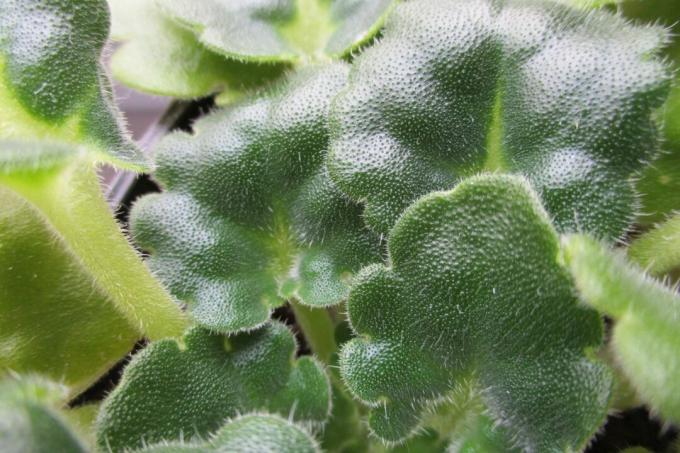
Tip: The name of the African violet comes from the color of the first cultivated form. This was violet blue and, together with the area of origin of the wild form, gave the African violet its name. In the English-speaking world, the African violet is called "African Violet".
The most beautiful African violet varieties
The African violet comes in many colors and also in multiple colors. From purple to white to pink or blue, there is something for everyone. Among the more than 2000 varieties there are even those with colored leaves, which are, however, among the rare African violets. Here we present the most beautiful African violet varieties from Saintpaulia ionantha before.
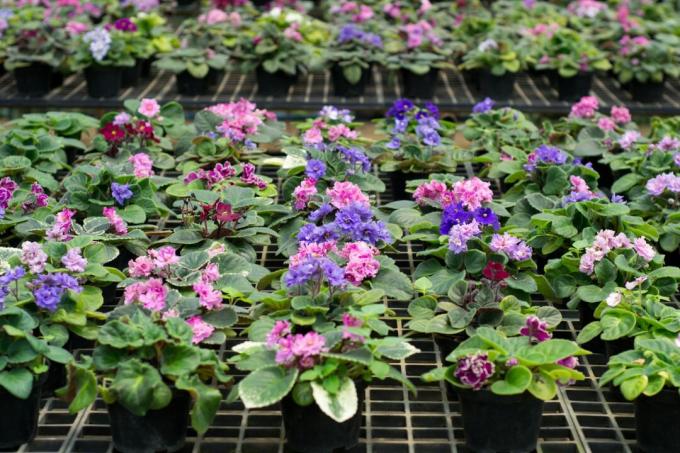
- ‘Arthur’: With this variety you get an African violet in blue.
- ‘Bordeaux’: This variety produces lovely bordeaux red flowers.
- 'Comet': Those who prefer an African violet in white are well served with this variety.
- "Morgan’s Sweet Patootie": The flowers of this variety are particularly small, have a bell shape and a delicate, salmon-colored tone.
- ‘Rob’s Chilly Willy’: An African violet with double flowers in light purple, which is also one of the mini African violets.
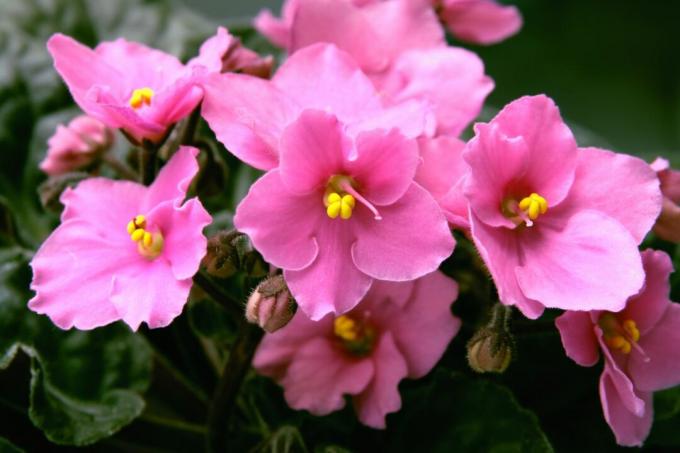
Location, soil and Co. for the houseplant
The African violet feels particularly comfortable in a bright and warm place without direct sun or drafts. A south-west facing window is well suited due to the high light requirements of the plant. So that all areas receive uniform light, the African violet should be rotated regularly or a reflector should be used. In winter, the light supply can be improved with a plant lamp.
A temperature of 18 - 24 ° C should be guaranteed all year round, because the houseplant is not winter hardy. Temperatures as low as 16 ° C can impair growth and flower formation.
Since high humidity is also beneficial, a bright kitchen or bathroom window is an ideal location for the African violet. In other rooms, the humidity should also be increased by using water bowls. Alternatively, you fill expanded clay into the saucer of the plant, place the pot on it and add water. In this way, the water evaporates directly in the vicinity of the African violet - without waterlogging. It is better to avoid spraying the leaves directly.

Tip: In summer the African violet can also stand outside - then the plant needs a shady spot. When it gets colder than 16 ° C, it has to be put back inside.
If you plant the African violet, choose a shallow pot because the plant does not have deep roots. The vessel should definitely have a drainage hole and the creation of a drainage layer made of coarse material is recommended. High-quality potting soil, such as ours, is suitable as a substrate Plantura organic potting soil. It retains its stable structure for a long time so that the roots do not suffer from a lack of oxygen. Water can store our peat-free soil well and give it to the plants. The best thing to do is to add about 30% sand, so that the permeability of the substrate is additionally improved.
African violet care
Watering and fertilizing are among the main components of African violet care. But a consistently high level of humidity is also important to keep the plant healthy.
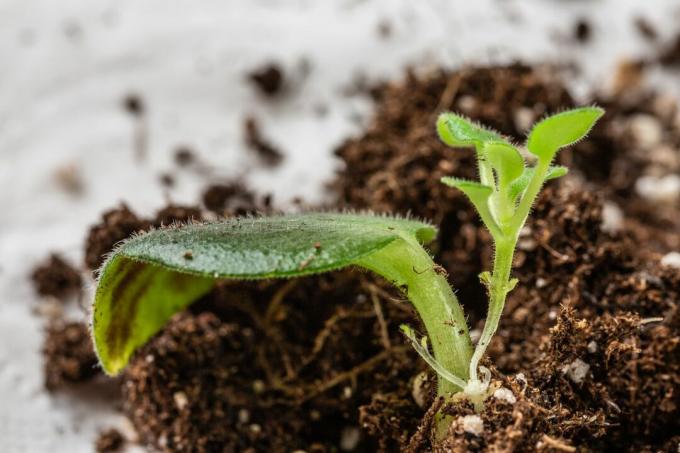
Pour African violets
You should always water the African violet when the surface is dry. It is very easy to find out whether this is the case with a finger test. It is best to use rainwater for watering or decalcify hard tap water before use. The water is then poured into the bottom of the coaster. Wait 15-20 minutes for the plant to get enough water. The rest has to be poured off again - the African violet's root system does not tolerate waterlogging. Watering from below is recommended for African violets, as the leaves are very sensitive to moisture and are quickly attacked by harmful fungi.
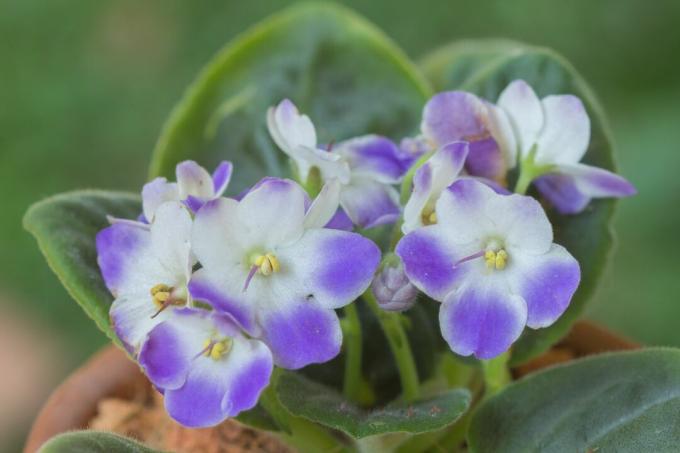
Fertilize
Regular nutrients ensure that the plant grows vigorously and healthily and produces plenty of flowers. The African violet is one of the frugal plants when it comes to nutritional requirements. It occasionally needs fertilizer, but cannot tolerate excessive concentrations of nutrients. It is therefore best to use a liquid fertilizer for indoor plants, such as ours Plantura organic indoor & green plant fertilizer. Our mainly organic fertilizer provides the African violet with important nutrients and contains microorganisms that promote root growth. It can be easily dosed and brought in via the irrigation water, making it quickly available to the plants. Half the dose should be fertilized every two to three weeks during the growth phase in spring and summer. In winter, one dose of nutrients every six to eight weeks is sufficient.
To cut
The small plants do not need to be pruned. Instead of cutting the African violet, only wilted leaves and flowers are carefully twisted out.
Tip: Dusty leaves are carefully cleaned with a brush, because a cloth cannot do much on the fine hair.
African violets &pot
You rarely have to repot the African violet, as it requires little space for the roots and even likes to feel a little tightness in the root area. However, if the pot is fully rooted, you should choose a slightly larger planter and repot the African violet, preferably in spring.

Diseases and pests
The African violet does not bloom, does the leaves sag or has small pests? Such diseases and pests have different causes, but can usually be combated successfully:
- Mosaic disease: If the leaves of the African violet change color like a mosaic and show light spots, there is a possibility that the plant has a viral disease. Avoid injuring the African violet as this is how the virus enters the plant. If the plant is already sick, it must be disposed of immediately.
- Aphids: Frequent, unwanted visitors to house plants are Aphids, which particularly often attack weakened plants. Since the delicate leaves of the African violet should not be washed off, you can only collect the pests by hand. Alternatively, you can Beneficial insects against aphids deploy. An example of an effective remedy is ours Plantura lacewing against aphids, Thrips & Co, which are simply applied to the plant.
- Mealybug: The sap suckers Mealybug They usually hide under the leaves or in the leaf axils and leave behind greasy residues. In addition to collecting the animals, biological agents such as our Plantura pest free neem to combat mealybugs, but also thrips. It can be easily dosed and used on ornamental plants against many insect pests.
- Thrips: The small pests are most likely to be recognized by their damage, namely the pin-prick-like lightening of the leaves. Against Thrips there are beneficial insects and biological agents.
- Hanging leaves: If the African violet lets the leaves droop, it has either received too much or too little water. You can easily check this on earth. Is it damp and smells musty or is it sunken and dry? Provide the plant with fresh substrate and adjust the watering amount. Another cause can be heart rot, that is, rot at the point of vegetation. It is caused by fungi in the soil in connection with too much moisture. To combat the affected parts of the plant must be generously removed.
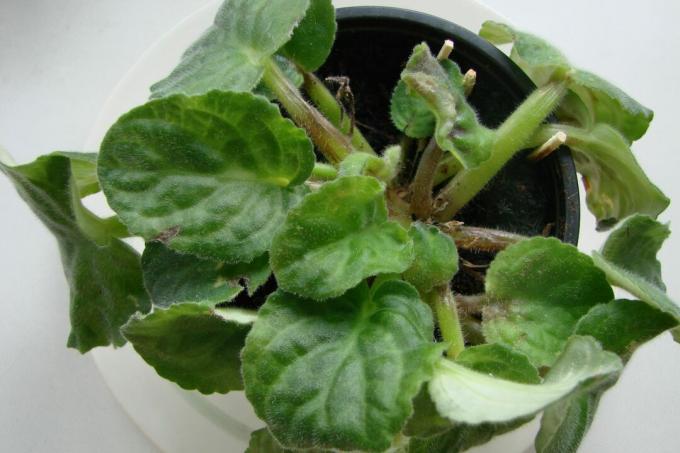
- Brown or yellow leaves: Low humidity, drafts, waterlogging or dryness are causes of leaf discoloration. Waterlogging and dry air in particular are common mistakes when it comes to caring for indoor plants.
- No flowers: The fact that the flowering African violet does not form flowers is mostly due to incorrect location conditions or incorrect care. In particular, too little light or an environment that is too cold can be a problem.

Propagate African violets
The African violet can be propagated vegetatively, i.e. asexually, - cloned, so to speak. Alternatively, it is propagated via seeds, i.e. generatively, whereby it is possible to create your own crossbreeds.
Leaf cuttings are often used for the vegetative reproduction of African violets. The method is simple and mostly successful. For this, preferably in spring, one or more leaves including the petiole are plucked from the mother plant. Now a flat pot is filled with sphagnum moss or potting soil. For the successful growth of cuttings, a nutrient-poor substrate, such as ours, should be used Plantura organic herb & seed compost, be used. In addition to the low nutrient content, the loose structure of our soil also supports root development. The leaf itself should not touch the ground, only the leaf stalk is inserted, otherwise mold will quickly settle. A temperature of over 20 ° C is just as important as high humidity for the cuttings to grow. To do this, you can place a bowl of water next to the cuttings, for example. After four to six weeks, new leaflets appear above the ground. This shows that the propagation was successful and the newly released plants can be repotted individually and placed in partial shade.

The African violet can also be propagated by dividing plants. To do this, carefully separate the rosettes into two parts in spring and plant them in separate pots. The plants are then placed warm and partially shaded. After about three weeks, they can be moved to a lighter place and cared for as normal.
Sowing the seeds is a bit more time-consuming, but it can be worthwhile because it enables combinations of different varieties. To do this, the African violets must first be pollinated by hand so that seed heads can form. The seeds are stored dry in a cool room in a dark container over the winter. The sowing is then carried out in spring on moist moss lying on the sowing soil. The ambient temperature should be 21 ° C. Cover the whole thing with cling film and ventilate it twice a day to prevent mold. After about three weeks you can see the first seedlings, which develop quite slowly. As soon as two to three pairs of leaves can be seen, the seedlings can be repotted in a nutrient-poor substrate and cultivated at 16-18 ° C. They are then gradually accustomed to the normal conditions of adult African violets.
Are African Violets Poisonous?
As an ornamental plant, the African violet is not suitable for consumption. There are some indications that it is intolerable or slightly toxic. Adults do not have to worry though, as it is rated as safe for them. However, it is of no use to them, children, or pets to eat the African violet.
If you like colorful flowers in your room, you should take a look at the Blood flower throw. The plant with the bright red, spherical shaped flowers is still relatively unknown to us as a houseplant.

